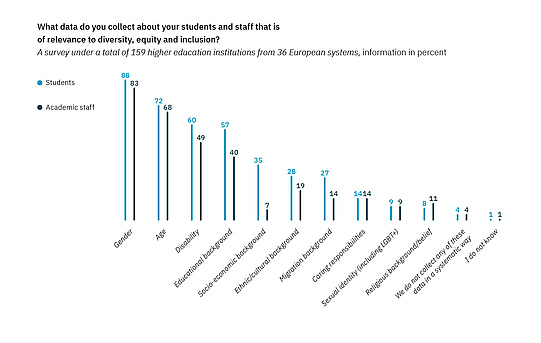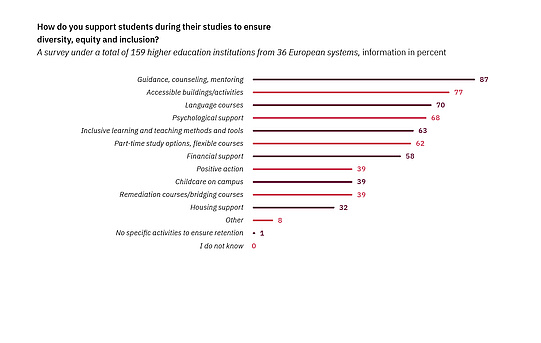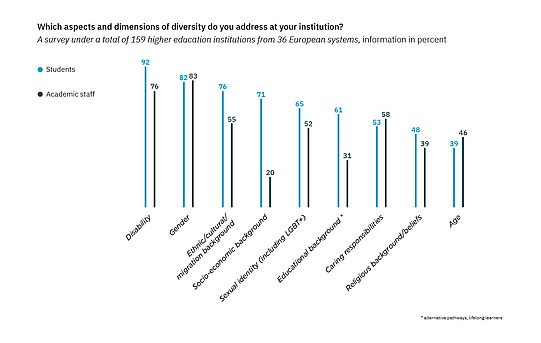Jump to the content
- {{#headlines}}
- {{title}} {{/headlines}}

Silke Wieprecht has never forgotten one particular review, although it happened a long time ago. The head of the Department of Hydraulic Engineering and Water Resources Management at the University of Stuttgart was a member of the selection committee for a prestigious fellowship for prospective academics. “Suddenly, I read this sentence written by a reviewer: ‘She’s not bad at all,’ he wrote about a highlyqualified candidate, ‘given that she’s a black woman.’” Silke Wieprecht found the sentence so absurd that she remembered it – despite the fact that her work on a host of different selection committees means she reads dozens of candidates’ application packages every year.

Do join in!
We want to take this topic of diversity beyond the limits of the Humboldt Kosmos magazine. Let’s talk about it! We look forward to sharing your thoughts or your own experiences on #ProgressDiversity.
At German unis the topic is still relatively new
Nearly everyone who deals with diversity can relate anecdotes like this. At German universities, it is a topic that is still comparatively new. Gülay Çağlar, professor of politics in the Gender and Diversity Division at FU Berlin and a Humboldt host, says she encountered the term for the first time in works on organisational theory in the private sector. “In business, the term ‘diversity management’ is quite common, clearly linked to the logic of exploitation,” she explains. “For universities this means the more diverse the perspectives, the more multifaceted and excellent the research.” But universities still had very different interpretations of diversity: for some it was a kind of extended equality policy, for others, an internationalisation tool and for yet others, a facet of anti-discrimination policy.
Diversity trumps gender – that suits some people very well

To begin with, Gülay Çağlar therefore suggests breaking the term down. Ultimately, it was all about portraying the diversity of society at a university: “Traditionally, we encounter the triad ‘gender, class, race’, but the list is often extended to include disabilities, for example, or sexual orientation or age.” And this is precisely where the problems start: whilst it is statistically straightforward to determine how equally women and men are represented in the student body and amongst researchers, there is often no data on other categories. Whether a woman applying for a professorship is the daughter of academics or unskilled workers is just as difficult to survey as the question regarding her ancestors’ nationality. And another cliff edge was threatening, Çağlar has observed: with all the efforts to apply diversity criteria, gender issues, in particular, could get pushed into the background. “Some people who are critical of promoting women look on it as an opportunity when gender differences are no longer such a focus of higher education policy,” says Çağlar.
“What diversity means depends on the country you are in.”
Above all, diversity policy was a process, she continues, explaining how she and her research team are helping FU Berlin to draw up a diversity concept. One of the first official acts was to share ideas with the university’s strategic partners worldwide. “At our Israeli partner university, for example, the question of religious affiliation emerged as a category of difference but played nothing like the same role in the other countries involved,” says Çağlar. So, how diversity is defined crucially depends on the specific conditions in the individual countries.
In the United States children are already confronted with the topic
The term is most firmly established in the United States. “Americans are confronted with the topic from their earliest childhood; after all, the US is an immigration country,” says Jeffrey Peck, former Dean at the City University of New York. “For example, I grew up in a corner of the United States where there are a lot of immigrants and a lot of African Americans.” After many years in Europe, he had a pivotal experience at his university in New York. “The fact that a society is highly heterogeneous does not automatically mean that people know how to deal with diversity.” He himself had only realised this in the course of his work as Dean and during his research on diversity. What was crucial was to incorporate differentness. Jeffrey Peck, who is also a member of the Board of Directors of the American Friends of the Alexander von Humboldt Foundation, quotes his favourite adage: “Diversity is being invited to the party. Inclusivity is being asked to dance.” These were not just empty phrases: in a diverse environment, ideas were questioned more rigorously; at best this would produce better answers. “Excellence and diversity are not opposite poles,” Peck emphasises, “they are mutually dependent.”

Empirical evidence for conclusions of this kind can be found, for example, in a recent study which appeared in the US journal PNAS (Proceedings of the National Academy of Sciences of the United States of America). The study followed the careers of thousands of doctoral candidates over a period of three decades – with unequivocal results: “Demographically underrepresented students innovate at higher rates than majority students,” the authors write, “but their novel contributions are discounted and less likely to earn them academic positions.”
Jeffrey Peck himself had a transformational experience when he was a student in Germany. “The fact that I, as a Jew, learned German was something special.” What he discovered was that when it comes to the diversity debate, you should not just think in terms of dualisms but consider various levels – that is, not just man or woman, black or white.

“Diversity is different in every context,” he says, formulating what research refers to as intersectionality. Every individual combines the most diverse dimensions within themselves which, depending on context, play a different role. In the US debate, according to Jeffrey Peck, racism is formative. In Germany, it was now unthinkable to hold a panel discussion only involving men; in the US, you also had to be sure that you didn’t just have white people on the podium. “I have the impression that, in Germany, diversity and gender are often seen as separate categories. In America, diversity is the superordinate category, and gender is an important sub-category.”
The expert community in china is divided

A journey to the opposite end of the world, from the United States to China. “In China, the gender issue does play a role, but not as pronounced as in places like Germany,” says Liqiu Meng. She is a professor of cartography at TUM in Munich and an authority on the Chinese science scene.
“In China, the schools of thought need opening up.”
Meng digs deep into history to address the topic of diversity. “For 1,300 years there was an imperial examination system in China regulating access to higher education,” she says. To this day, entrance examinations were standard practice for university courses. That was why the gender ratio amongst students was more or less equal, without the need for quotas. “Up to doctoral level, it remains roughly balanced – it only tips after that”, Liqiu Meng comments. “Fewer women attempt to get a professorship, which has to do with the traditional distribution of roles.” In one particular aspect of diversity, Liqiu Meng does, however, identify a Chinese speciality: “Unfortunately, the expert community is increasingly fragmenting into schools of thought that tend to compete with one another rather than collaborate,” she says. “The talent system at Chinese universities is still steered by a planned economy.” As a professor in Germany she was free to recruit her own staff. “In China, on the other hand, professors are not allowed to appoint more than one doctoral student per year,” explains Meng, who has been an expert on the Humboldt Foundation’s International Advisory Board for many years. In order to achieve greater diversity in China, these self-contained schools of thought would, first of all, have to be opened up. That was why top universities had gradually stopped employing their own graduates: doctoral students now had to change university for their postdoc positions and even Bachelor’s graduates had to do their Master’s elsewhere.
Urbanites have an easier time at African unis
Universities in Africa face different issues when it comes to academic diversity. “Here the urban-rural gap is a major topic,” says Romain Glèlè Kakai. The professor of biometrics from Benin is a Humboldt Foundation committee member and chair of the African German Network of Excellence in Science. He is very familiar with the situation in West African countries. “Someone who comes from a city here has better access to education and usually comes from a more affluent family,” he says. Consequently: “just ten years ago, students from rural areas, which are also often difficult to reach, were not well represented.” Recently, however, policy-makers had tried to introduce countermeasures. For a number of years, university applicants from disconnected regions had gained easier access to scholarships; moreover, quotas had been introduced that took account of geographical factors. Another development in recent years had seen women being given privileged access to scholarships. “These incentives are an attempt to increase diversity at universities,” says Kakai. “But, of course, this only functions to the extent that the state budget allows for the expenditure.”
From West Africa to India

The next stop on our journey is Mumbai, India. This is where Mala Pandurang works at Dr. BMN College of Home Science, an exceptional institution: when she is teaching, the class in front of her is entirely composed of young women. And the professors are largely female, too. “We are a university exclusively for women,” the English literature professor explains. Women account for more than 40 percent of students in India but on the topic of diversity, gender issues are not the only pressing problems: “There are huge socio-economic disparities,” says Pandurang who works in an honorary capacity as a Humboldt Foundation Ambassador Scientist in India. Wealthy parents are in a much better position to send their children to university than poor families, and these differences are exacerbated by the caste system. Although according to the Indian Constitution of 1950 no one is supposed to experience discrimination on the grounds of their caste, in day to day life the system often perpetuates.
“In India, too, the biggest difficulty is the limited budget.”
In 2016, a dramatic incident hit the international headlines: at a university, a 26-year-old doctoral student who belonged to the Dalit caste, formerly known as “untouchables”, committed suicide. He had complained about unfair treatment by the university. An activist for Dalit rights, his own scholarship had been stopped and his student accommodation withdrawn. His death triggered protests all over India. Across the world, the media reported that his suicide was no exception at Indian universities. Nonetheless, Mala Pandurang thinks the country is on a hopeful course. Quotas and a new educational concept were pointing in the right direction. “But the biggest difficulty is the limited budget” which was often absent from the national budget. “Private sponsors and alumni associations are trying to bridge the gap, at least partly.”
Back in Germany with Silke Wieprecht, the Stuttgart water resources professor who, for many years, was chair of the selection committee for the Humboldt Foundation’s Georg Forster Research Fellowships and Awards. “The trouble with selection processes is that you simply can’t identify, for instance, the candidates’ social background from their application documents,” she says. You could read about their university education, research interests and how the reviewers evaluated them – but not whether they were the first person in their family to go to university or came from a socially disadvantaged region.

Traditionally, the Humboldt Foundation does not apply quotas. It sponsors excellent researchers. And it is clear that the Humboldt Network draws its power from the diversity and internationality of its members. In its almost 70-year history, the Humboldt Foundation has united more than 30,000 researchers worldwide: current sponsorship recipients and alumni in all disciplines from over 140 countries. Nonetheless, in several consecutive selection rounds for Germany’s most valuable research award, the Humboldt Professorship, for example, not a single woman was selected. Not least in response to this situation, the Foundation recently commissioned a gender potential and needs analysis based on data from 14 countries around the world. It seeks to ascertain how high the percentage of qualified women who could potentially be recruited for a research stay in Germany really is and what their needs are. According to the head of the study, Andrea Löther of the Centre of Excellence Women and Science at the Cologne-based Leibniz Institute for the Social Sciences, it is also about factors that may influence women’s perception of whether they can envisage a research stay abroad: “For instance, what role is played by the female applicants’ family situation or the discipline in which they conduct research?” The aim, Löther continues, is to formulate clear recommendations for action when the study is completed at the end of 2021.
“Without data, you are just left with declarations of intent because you can’t measure any progress at all.”
For Jeffrey Peck from the United States one recommendation is already a given: in order to achieve greater diversity, more data must finally be collected – particularly in Germany where data protection often poses obstacles. “If I want to promote researchers from a migrant background or ethnic minority, I must know the figures – otherwise you are just left with declarations of intent because you can’t measure any progress at all.”


